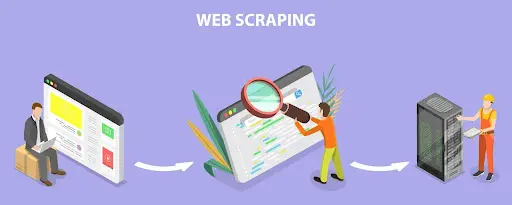Companies are increasingly embracing web scraping. The reasons for this shift include the need to gain access to a larger volume of data, improve the efficiency of data collection, improve their existing data repository, and stay ahead of the competition. However, web scraping has its challenges: from the implementation of anti-web scraping techniques by multiple websites, which can hinder data extraction, to the increased popularity of dynamic websites, but hiring developers for startup can help you solve this problem. Fortunately, you can optimize your web data extraction operations to overcome these challenges. In this article, we discuss seven expert web scraping optimization tips. But first, let’s remember what web scraping is.
What is web scraping?
Also known as web data harvesting or web data extraction, web scraping is the automated process of collecting data from websites. Generally, web data harvesting provides a wealth of accurate public data from third-party websites. This data can range from the number of competitors and consumers in a market to the products and prices in a particular niche. While web scraping is central to Search Engine Optimization (SEO), web scrapers can also gather information from reviews, social media platforms, and other websites.
However, scraping data from the web isn’t always a walk in the park. In fact, in a bid to safeguard the data stored on their web servers and to prevent unnecessary requests from bots, which in 2021 accounted for about 64% of all internet traffic, web developers are increasingly implementing anti-bot and anti-scraping measures, including:
- CAPTCHAs
- Sign-in and login requirements
- User agent and header prompts
- Honeypot traps
- IP address monitoring and blocking
- Dynamically updating content based on AJAX
- Browsing behavior analysis
Moreover, some businesses restrict access to residents of a particular geographical location. This practice, known as geo-blocking, hides data from a worldwide audience. Fortunately, you can access such content using a geo-targeted proxy, such as a UK proxy, to access United Kingdom content. At the same time, you may need more technical background to navigate what can sometimes be a complicated data extraction process. Fortunately, there are several ways to get around these problems. They entail optimizing your web scraping operations.
7 Expert Tips
- Select the right tools
A proxy server is an intermediary that helps you anonymize your web requests by routing all outgoing and incoming internet traffic through itself. In doing so, it assigns the outgoing requests a new IP address, effectively hiding the actual IP address. When it comes to web scraping, the suitable proxy should rotate the IP addresses periodically to limit the number of requests originating from the same source. Additionally, if you want to scrape geo-blocked content from a country such as the UK, it’s essential to use a UK proxy.
Note that you should select a programming language with a requests library when creating a web scraper from scratch. Python is an excellent place to start, as it’s an easy language to learn and code.
- Use a headless browser or JavaScript rendering library
Websites are increasingly incorporating JavaScript, given that it enables the creation of dynamic webpages. But this can be problematic because most web scrapers are designed to extract data from static web pages. Fortunately, you can use a headless browser or a JavaScript rendering library, such as Selenium in Python, to get around this problem.
- Mimic human browsing behavior
It’s important to limit the number of requests sent in order not to raise suspicion. Ordinarily, a web scraping bot can send multiple requests simultaneously, which can trigger anti-bot measures. Thus, mimicking human browsing behavior helps to ensure success.
- Procure a web scraper from a reputable service provider
You can procure a web scraper from a reputable service provider if you don’t have a technical background. Such an organization provides a ready-made product that’s maintained and updated around the clock and has 24/7 customer support included.
- Follow ethical practices
Some websites include a robots.txt file that contains instructions on web pages that bots shouldn’t access. It’s important to abide by such instructions. It’s equally crucial not to scrape content that’s hidden behind a login page, especially if such content isn’t meant for public consumption.
- Rotate user agents and headers
Regularly change the user agent and headers. It gives the illusion that web requests originate from different devices, even when the scraper is on one device. Importantly, this practice helps prevent IP blocking.
- Cache pages to avoid making unnecessary requests
It’s thoughtful to cache HTTP requests and their responses, which store a list of web pages that the web scraper has already visited, thus avoiding sending unnecessary requests.
Conclusion
Web scraping offers numerous benefits to businesses, but it isn’t without a few challenges. Fortunately, you can optimize your web scraping operations by implementing a few expert tips. These tips include storing a list of web pages that have been accessed, rotating the user agents and headers, following ethical web scraping practices, and using the right tools, just to mention a few.
- Which joiner shows a result between coordinate ideas? - July 25, 2024
- ¿DONDE ESTA EL VERSO QUE DICE (DETRAS DE CADA IMAGEN HAY UN DEMONIO)? - July 25, 2024
- Expert Witnesses: Here’s Why Your Personal Injury Case Needs One - July 25, 2024



